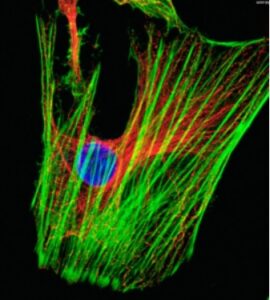Origins of the HeLa Cell Line
The HeLa cell line is an immortal cancer cell line. It is termed “immortal” since the cells can replicate indefinitely in culture. The original cells came from a visible malignant cervical tumor in the body of a 31-year-old African American woman named Henrietta Lacks. The cells were taken in 1951 and given to Dr. George Gey, who produced the original cell line. Henrietta Lacks died the same year, in October, from the very cancer cells that have since been used in science to save thousands of lives.
Currently, there are strains of HeLa cells all over the world that have evolved in cell culture, and it is estimated that more HeLa cells have been cultured than were originally in Henrietta Lacks’ body.
Figure: Fluorescent light micrograph HeLa cervical cancer cell with actin (green), tubulin (red), nucleus (blue).

Contaminated HeLa Cells
HeLa cells are a popular research tool due to the cell line’s remarkable durability and immortal nature. They are so durable, in fact, that in 1974, a researcher named Walter Nelson-Rees suggested that all cell cultures have been contaminated with HeLa. Although not all cells were contaminated, it became evident that many of the cells in labs around the world were contaminated. The uncontrolled growth of HeLa is such a problem in many labs that if the lab wants to use HeLa cells it cannot use any other cell line in fear of compromising good science. It has been demonstrated that 10-20% of existent cell lines have been infiltrated by HeLa. HeLa cell doubling time is 24 hours, and, years later, they are still some of the strongest cells known to science. In fact, citing their ability to replicate, the disparity between human and HeLa cells, and their ability to proliferate unchecked despite human attempts to contain them, some scientists have described HeLa as its own species, and a highly successful one, at that.
Controversy Surrounding HeLa
Despite the efforts of Johns Hopkins doctors, Henrietta’s cancer proved to be too powerful to treat. Henrietta had undergone several radium treatments in hopes of being cured of her cervical cancer and being capable of having children in the future. However, the doctors had not informed Henrietta that the radium treatments would leave her infertile until it was too late. Had Henrietta been aware of the consequences of the radium treatments, she would have never consented to them. The doctors also chose to not inform Henrietta that her tissue samples were being given to Dr. Gey for research purposes, later to be commercialized and sold for profit.
The HeLa cell line sparked a 1950s debate on medical ethics because the HeLa cells were propagated and commercialized without the knowledge or permission of Lacks or her family. In fact, the HeLa cell line’s sheer ubiquity is how Henrietta Lacks’ family, far removed from the field of scientific research, came to know about it 24 years after the death of Henrietta Lacks.
The debate over patient consent led to the establishment of the Common Rule, which has been in practice since 1991. Common Rule requires doctors to inform patients when they are conducting research and gives those patients the choice to participate or not.
Cytogenetics
HeLa cells are hypertriploid and have a modal chromosome number of 82, with four copies of chromosome 12 and three copies of chromosomes 6, 8, and 17. The modal number ranges from 70 to 164. 98% of cells display a small telocentric chromosome, and four typical HeLa marker chromosomes have been reported in the literature.
Links
siRNA Delivery – In Vivo Transfection Kits
CRO Pre-clinical Research Services: Xenograft animal models
GLP-compliant Cell Banking services
Generation of Stably Expressing Cell Lines in 28 Days
Stable RNAi Cell Line Generation: Stable Gene Knockdown
In Vivo siRNA Delivery: Tissue-targeted siRNA
Encapsulation of Protein, RNA, mRNA, and DNA Molecules into Liposomes
The Amazing Cells of Henrietta Lacks
HeLa Cell Line │ Cell Culture Information │ Transfec Information │Get HeLa Transfection Reagenttion